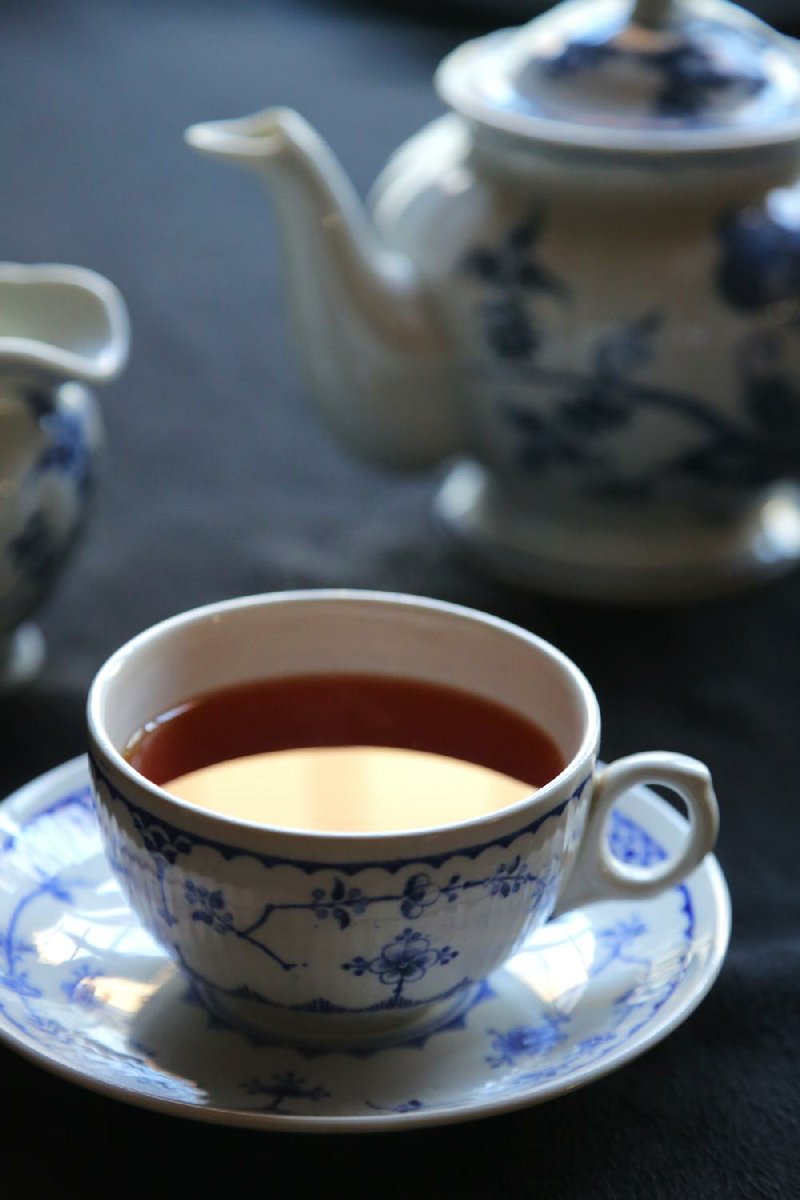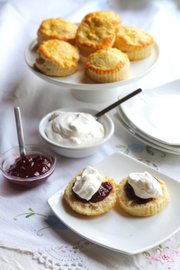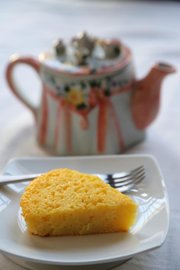The Downton Abbey phenomenon has encouraged a surge of Anglophilia. All things English are cool. But as a lifelong Anglophile, the recent Downton-mania is just a matter of everyone else coming around to my way of thinking.
Growing up, visits to my grandparents' home meant staying in a house with English coffee-table books, prints of the English countryside, shelves of Agatha Christie novels and, at 4 o'clock, my grandmother's daily pot of tea. It was a ritual she began after one of her trips overseas and when my sisters and I were old enough, she shared it with us.
There's a ritual to tea, with the delicate cups and saucers, the pretty teaspoons, the teapot and milk pitcher and the bowl of sugar cubes. All of it arranged on a tray and carried to the living room or the porch and consumed in comfortable chairs while having a nice visit.
It's a ritual that, when combined with some very tasty treats, elevates the afternoon snack from something rushed and mindless to something leisurely and satisfying to the soul as well as the stomach.
Tea can be a simple, casual sit-down for two. Or it can involve nice china, embroidered napkins, silver teaspoons and a gathering of friends.
Over the years, my grandmother and I have expanded our repertoire of sweet tea treats from those early days of cinnamon toast. Now, teatime might mean a "cream tea" (tea and scones with cream and jam or a cream-and-jam-filled Victoria sponge) or tea with a lemony tea cake or buttery shortbread.
These treats are not only easy to make, they're also easily adaptable, good for formal entertaining or to be eaten solo with nothing but a good book for company.
The first step, though, is brewing a pot of tea.
To start, fill a kettle with cold water and bring it to a full boil. Meanwhile, pour hot water into an empty teapot to warm it. Pour out that water, add the tea (one spoon of loose tea per cup or one bag less than the number of cups) and fill the pot with hot water from the kettle. Let it steep for 3 to 5 minutes. Remove tea bags.
If the teapot isn't large enough to hold enough tea for everyone, make the tea extra strong and have a jug of hot water handy. When serving each cup, add some water to dilute the brew and there should be enough to go around.
An average American, when hearing the word "scones," thinks of a nearly flat cakey triangle with some sort of fruit. Those are delicious and tea-worthy, to be sure, but they're not tea scones.
Traditional English tea scones are usually round, thick and somewhat resemble a biscuit. They're lighter inside, crunchier outside and overall sweeter. They can include raisins or other dried fruit, but not always. They're easy to make and simple-looking, but when eaten with cream and jam, they are heaven.
To eat them, one splits them open horizontally, then eats the two halves separately with lots of clotted cream and whatever flavor of jam is on hand. In England, one usually finds strawberry but raspberry is excellent. Putting the two halves back together in sandwich form is generally frowned upon -- and very messy.
Basic Scones
2 cups all-purpose flour
1 tablespoon baking powder
2 tablespoons granulated sugar
1/2 teaspoon salt
6 tablespoons butter
1/2 cup buttermilk
1 egg, lightly beaten
Heat oven to 425 degrees.
In a mixing bowl, combine the dry ingredients. Using a pastry cutter or two knives, cut in butter until mixture resembles coarse cornmeal. Make a well in the center and pour in buttermilk. Mix just until dough clings together and is sticky, being careful not to overmix.
Turn dough out onto a floured work surface and using your hands, gently shape dough to 3/4-inch thick. Using a 2-inch biscuit cutter, cut dough into rounds and place on an ungreased cookie sheet. Don't let the sides touch. Brush each scone with beaten egg. Bake until light golden brown, 10 to 20 minutes.
Makes 12 (2-inch) scones.
Recipe adapted from If Teacups Could Talk by Emilie Barnes
Clotted cream, a thick, rich cream about the consistency of whipped butter, is the traditional accompaniment to scones but hard to find here. It is possible to make it at home, but the process involves many hours of cooking cream in the oven, then skimming cream off the top.
This recipe for mock cream is much faster and easier and while it's not quite the same thing (it's lighter and sweeter), it's still wonderfully tasty with scones and jam.
Mock Devonshire Cream
1 cup whipping cream
1/2 cup sour cream
2 tablespoons confectioners' sugar
1 teaspoon vanilla extract
In a large bowl, beat whipping cream at high speed until soft peaks form. Fold in remaining ingredients.
Makes 2 3/4 cups.
Recipe adapted from Southern Living
This cake was said to be a favorite of Queen Victoria. While there are dozens of recipes out there, we've gravitated to this one.
Victoria Sponge
3/4 cup softened butter
3/4 cup granulated sugar
3 eggs
1 1/2 cups all-purpose flour, divided use
1 teaspoon vanilla extract
1 1/2 teaspoons baking powder
Jam, to taste
Sifted confectioners' sugar, for garnish
Heat oven to 350 degrees. Butter and flour an 8-inch round cake pan.
In a bowl, using an electric mixer, cream butter and sugar until light and fluffy. Add eggs, one at a time, adding 1 tablespoon of flour with each egg. Beat until combined well. Stir in the vanilla.
In another bowl, sift remaining flour and baking powder. Stir ingredients into butter mixture until combined well, then pour into the pan, smoothing the surface.
Bake 45 to 50 minutes or until a wooden pick inserted near the center comes out clean. Be careful not to let it overcook or it might be too tough around the edges.
In the pan on a rack let the cake cool for 5 minutes, then invert it onto the rack to cool completely.
With a serrated knife, cut cake horizontally into two layers. The filling can be any flavor of jam or preserves with buttercream, mock Devonshire cream, or the fruity spread on its own.
For an extra-fancy cake, use a doily to stencil when sprinkling with confectioners' sugar to make a pretty pattern.
Makes 1 cake.
Recipe adapted from Southern Living
This dense, exceptionally moist cake resembles a pound cake more than a traditional sheet or layer cake. It's lemony without being overpowering.
Mrs. Pettigrew's Lemon Cake
2 lemons
3/4 cup PLUS 3 tablespoons granulated sugar, divided use
8 tablespoons salted butter or margarine, softened
2 eggs, beaten
3/4 cup all-purpose flour
6 tablespoons milk
Heat oven to 325 degrees. Grease and line a 7-inch round cake pan or an 8-inch loaf pan with parchment or wax paper.
Grate the zest from the lemons and set aside. Juice one of the lemons (save the remaining lemon for another use).
Combine the lemon juice with the 3 tablespoons sugar and set in a warm place until sugar dissolves and forms a syrup.
Cream butter and remaining sugar until light and fluffy. Gradually add beaten eggs, beating well after each addition. Stir in lemon zest and flour and beat thoroughly. Add milk and beat again.
Pour into prepared pan and bake for 1 hour, or until the cake springs back when gently pressed.
Immediately after removing the cake from the oven, prick the top with long-tined fork or thin skewer and pour lemon syrup over top until completely covered. Cool in pan to allow syrup to be completely absorbed.
Recipe adapted from Having Tea by Tricia Foley
Simple, buttery and crisp, these are a nice side for a solitary afternoon tea.
The dough keeps well in the refrigerator (wrap in parchment paper and seal in plastic bag), so it's easy to take out and bake as many as you want on a given day.
Scottish Shortbread
1 cup PLUS 2 tablespoons granulated sugar
2 cups butter, softened
3 cups sifted all-purpose flour
1 2/3 cups rice flour
Heat oven to 275 degrees.
Mix sugar and butter together with fingers. Gradually add flours, blending until mixture leaves hands clean. Shape in small pieces or long rolls, slice and prick tops with tines of a fork. Bake 35 to 40 minutes or until lightly browned.
Makes 4 to 5 dozen cookies.
Recipe from Gracious Goodness: The Taste of Memphis by Elizabeth Hutchinson Redfearn
Food on 01/07/2015


